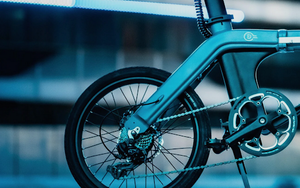Are Electric Bikes Allowed on Trains?
Jul 03, 2024
Are Electric Bikes Allowed on Trains?
Electric bikes have gained popularity in recent years as a convenient and eco-friendly mode of transportation. With their increasing presence on city streets, many bike enthusiasts wonder if they are permitted on trains. This article aims to explore the regulations and considerations surrounding transporting electric bikes on trains.
Understanding Electric Bikes
Before delving into the intricacies of electric bikes on trains, it's essential to understand what exactly they are. Electric bikes, also known as e-bikes, are bicycles equipped with an electric motor. The motor assists the rider's pedalling effort, providing an extra boost of power, and their adoption is on the rise! Approximately 50,000 - 60,000 are sold in the UK each year with substantial growth predicted over the next 30 years.
Key Features of Electric Bikes
Electric bikes come with various features that set them apart from traditional bicycles. These features include:
- Electric Motor: As mentioned earlier, the electric motor is the primary distinguishing feature of e-bikes. It can be powered by a rechargeable battery, which provides assistance to the rider.
- Pedal Assist and Throttle: Electric bikes often offer different modes of operation. Pedal assist mode provides power assistance to the rider's pedalling effort, while throttle mode allows the bike to be operated solely using the motor.
- Battery: The battery is the energy source of an electric bike. It stores electricity needed to power the motor. Battery capacity varies among models and affects the range of an e-bike. The Eleglide T1 has a range capacity of 62 miles when pedal assisted with a 450 Wh battery.
- Speed and Range: Electric bikes can reach speeds of up to 20 to 28 mph, depending on the model. The range of an e-bike refers to the distance it can travel on a single battery charge.
- Weight: Electric bikes are generally heavier than regular bicycles due to the added components, such as the motor and battery. The weight can affect manoeuvrability and transportation, so it’s something to bear in mind. The Himo Z20 weighs 22kg, so can still be easily transported.

Regulations on Transporting Bikes on Trains
Transportation regulations, regarding electric bicycles on trains, vary across different regions and transportation providers. However, there are general rules that apply to most train networks.
General Rules for Bikes on Trains
Most train networks allow bicycles on board, but they may have specific guidelines to ensure safety and convenience for all passengers. Some common rules for transporting bicycles on trains include:
Booking Requirements
It is often necessary to make a reservation for transporting bicycles on trains, especially during peak travel times.
Bike Racks or Storage Areas
Train carriages may have designated spaces for bicycles, such as bike racks or storage compartments. Bikes must be securely stored to prevent damage or disturbance to other passengers.
Disassembling
In some cases, bicycles may need to be partially or fully disassembled before being allowed on trains. This is especially true for larger bikes or when limited storage space is available.
Packaging
Bicycles are required to be properly packaged or covered to prevent any damage or
dirt from spreading to other passengers' belongings.
Timing and Restrictions
Some train networks only allow bicycles during specific hours or have restrictions on certain types of trains, such as high-speed or intercity trains.
When it comes to electric bikes, train operators often have additional policies due to their unique characteristics. These policies are primarily focused on safety and the potential risks associated with electric bike transportation.

Factors Influencing Electric Bikes on Trains
Transporting electric bikes on trains requires consideration of specific factors that may affect their permissibility and safety during travel.
Size and Weight of Electric Bikes
Electric bikes are generally heavier and bulkier than traditional bicycles due to the added components. When determining whether an electric bike is allowed on a train, it's crucial to consider whether it meets the size and weight restrictions imposed by the train operator. These restrictions ensure that the bike can be safely stored and doesn't pose a risk to other passengers or staff.
Battery Safety Concerns
The most significant concern when transporting electric bikes on trains is battery safety. Lithium-ion batteries, commonly used in e-bikes, have the potential to catch fire or explode if damaged or mishandled. To mitigate this risk, some train networks may have specific requirements for battery transportation, such as:
- Battery Removal: Requiring the removal of the battery from the electric bike before boarding the train.
- Battery Packaging: Requiring the battery to be securely packaged to avoid any short-circuit or damage during transit.
- Battery Capacity Restrictions: Imposing limits on the battery capacity allowed on trains to minimise the risk of accidents.
How to Prepare Your Electric Bike for Train Travel
If you're planning to take your electric bike on a train journey, proper preparation is essential to ensure a smooth experience. Follow these steps to prepare your electric bike:
Disassembling Your Electric Bike
Depending on the train operator's policies and storage limitations, you may need to partially disassemble your electric bike. This typically involves removing the battery and folding or detaching certain components, such as the handlebars or pedals. It's advisable to familiarise yourself with your e-bike's disassembly process and practise it in advance to save time and prevent any damage or difficulties during travel.
Packing Your Electric Bike Safely
Once you have disassembled your electric bike, it's crucial to pack it in a way that ensures its protection and convenient transportation. Consider using a sturdy carrying bag or specialised bike case to cover and secure your electric bike. Make sure all loose parts are safely stored, and the bike is well-padded to prevent any scratches or damage during handling.

Alternatives to Taking Electric Bikes on Trains
If transporting your electric bike on trains is not feasible or permitted, there are alternative options available for bike enthusiasts to explore.
Bike Rental Services
Many cities offer bike rental services, providing easy access to bicycles for short-term use. Bike rental services allow individuals to enjoy the benefits of cycling without the hassle of transporting their own bikes on trains. These services often have various bike types, including electric bikes, catering to different preferences and needs.
Public Bike Sharing Systems
Public bike sharing systems, such as citywide bike-sharing programs, provide an efficient way to access bicycles without the need for personal ownership or transportation. These systems typically offer a network of conveniently located bike stations, allowing users to rent bikes for short trips and return them at any station within the system. Public bike sharing is an excellent option for individuals who require occasional access to electric bikes.
So, Are Electric Bikes Allowed On Trains?
In conclusion, the permissibility of transporting electric bikes on trains depends on the specific regulations set by train operators. Key considerations include the size and weight of the bike, as well as battery safety concerns. Proper preparation of the electric bike, such as disassembling and packing it securely, is crucial for a hassle-free travel experience.
However, if taking an electric bike on a train is not feasible, alternatives such as bike rental services and public bike sharing systems provide convenient options for bike enthusiasts. Always check with your local train operator to ensure compliance with their policies and guidelines regarding electric bikes on trains.






